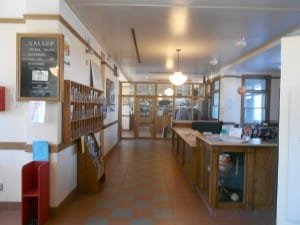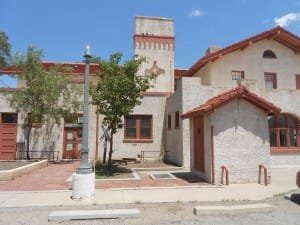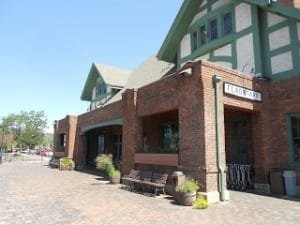When the American railroads were expanding during the latter part of the nineteenth century, Texas was in an ideal position. It was also growing rapidly and had plenty of available land. The last half of our article lists several historic train depots in Texas and the west that make excellent trip stops.
Thank you for reading this post, don't forget to subscribe!
Historic Texas Train Depots
When you research the golden days of railroading you’ll come to recognize that the state of Texas might of had the largest number of different railroads crossing it’s borders.
Texas railroads were numerous as were the train depots servicing them. Just as with the case of railroad towns all across the country, railroads came and went and many merged together. Fortunately, a good number of these historic train stations still exist in Texas as they do around the entire country.
The Katy Flyer
One of the historic railroads that came down from the north into Texas was the MKT, commonly referred to as the Katy. This was the Missouri-Kansas-Texas Railroad. In fact the Katy was the first railroad to come down into Texas from the north. Waxahachie Texas was on the main line of the Katy Flyer, a very popular named rail route which ran from St. Louis Missouri to Galveston Texas. The entire journey was made in thirty-seven hours.

The Katy Flyer offered buffet sleeper cars for those passengers who chose to have meals aboard the train. The other option was to take meals at the MKT eateries located in some select stops such as Dallas. In some ways this mirrored the arrangement Fred Harvey had with the Santa Fe Railroad. The MKT Katy Flyer operated over this route for decades lasting all the way to 1961.
The Rock Island
The last of the Rock Island passenger trains to travel through Waxahachie and utilize the depot was the Sam Houston Zephyr. This was the BRI route connecting Fort Worth Texas and Houston which started service in 1936. The year 1936 also saw the large Texas Centennial celebrations throughout the state. Travel time on the new streamlined Sam Houston Zephyr was originally five hours with only four stops along the way, Waxahachie being one of them. Because of declining profits and competition from automobiles and airlines the Sam Houston Zephyr discontinued service in 1966.

Texas Railroading Heading West
Anyone who has spent time researching the history of specific railroads will understand that mergers and acquisitions were commonplace. There were a great number of situations where very small lines were chartered to build rail lines over perhaps a few hundred miles. Over the years and in some cases in only a few years these lines merged with other larger railroads and these as well were acquired by even larger railroads. The southern branch of the Katy Railroad was primarily made up of several of these smaller lines being acquired.
Geographically, Texas, by reason of it’s size, was a crossroads for railroads for two main reasons. The state was growing steadily and passenger service was in demand to cities such as Fort Worth, Dallas, Houston and San Antonio.
The second reason was that efforts were made from Texas to build a southern transcontinental route to either Los Angeles or San Diego. Such an effort was begun by the old Texas Pacific Railroad which ultimately ended with the Southern Pacific route from Los Angeles to New Orleans via El Paso, San Antonio and Houston.

As you travel around Texas you’ll have the opportunity to explore many historic train stations from railroad’s golden age.
While the Denver and Fort Worth Railroad put Amarillo on the map,other railroads were building into Amarillo Texas. Mergers and acquisitions took place and eventually the Chicago, Rock Island and Gulf Railroad was completed.
By 1910, a rail line was built from Amarillo west to the New Mexico border. The Rock Island would eventually run to Tucumcari New Mexico where it would join up with a Southern Pacific line and offer through service from Chicago to the west coast. This line would be in direct competition with the Atchison Topeka and Santa Fe Railroad at that time.

Eventually the transcontinental routes to the west coast comprised the southern route with the Southern Pacific Railroad at the helm, the Atchison Topeka & Santa Fe (Santa Fe Railroad) with it’s general southwest route from Chicago through New Mexico and northern Arizona into Los Angeles. The Union Pacific route from Chicago through Nebraska, Wyoming, Utah and Nevada ending in the San Francisco Bay area and the northern route which ran out of Minneapolis/St. Paul to Seattle and built by the Northern Pacific Railway.
Below are links to additional Trips Into History articles you may enjoy…
Railroads in Texas / The Frisco
A Tour of an Historic Pullman Car
The Famous U. P. Big Boy Steam Locomotive
Visit Luling Texas / Railroads, Oil and Watermelons
Surviving Historic Trail Depots Around the U.S.
Many of the old train depots today that have survived have been taken over by historical societies and cities and towns themselves. Some serve as excellent museums with artifacts and photos of the old passenger trains that visited. Some others are a combination of both, serving as museums and trains stations served by Amtrak.

Below is just a small sample of historic train stations that have survived the decades since the days when passenger railroading was in it’s golden years. They make good additions to trip planners and most are filled with large historic collections.
Amarillo Texas
Amarillo was put on the map thanks to the railroad and ranching. The Texas Panhandle was a natural crossroads to the west and Amarillo benefited. Although there is no passenger service today and hasn’t been since 1970 the Amarillo rail yard is very busy with BNSF freight traffic. The old Santa Fe Amarillo train depot, built in 1910, and the surrounding six acres are now owned by the City of Amarillo. The train station is located just east of the downtown area.
Waxahachie Texas
The Waxahachie Texas old passenger train station built in 1886 served the Katy Railroad, also known as the M-K-T. The station is located just south of the town square and today. Waxahachie itself is known to many as the Gigerbread City because of the historic homes still standing built prior to 1900. The train depot closed when the Katy merged with the Union Pacific. Today Waxahachie sees a good amount of Union Pacific freight traffic. The old Katy depot is also across the street from the old Santa Fe Railroad depot which gives you a good comparison of the different architecture. Waxahachie Texas is located off Interstate 35 about 30 miles south of Dallas.
Temple Texas
The Temple Texas train depot is a museum and a working passenger train station. It is the third stop heading south from Fort Worth on Amtrak’s Texas Eagle which operates between Chicago and San Antonio Texas. Temple Texas is located along Interstate 35 about 35 miles south of Waco and about 65 miles north of Austin.
Lamy New Mexico
The Lamy New Mexico train depot serves Santa Fe which is about 15 miles to the north. The Lamy train depot was built in 1909 by the Atchison Topeka & Santa Fe Railroad. At one time the railroad ran a spur line to Santa Fe where passengers would connect to. Today the depot is an active Amtrak stop for the Southwest Chief which runs daily between Chicago and Los Angeles. Lamy is an old historic spot outside Santa Fe and definitely worth a visit.

Flagstaff Arizona
Today’s Flagstaff Arizona train depot is an active passenger station for Amtrak’s Southwest Chief. The current depot was built in 1926 by the AT & SF. It is just to the south side of Flagstaff’s historic district and serves as a Visitor Center as well as a passenger station.
Tucson Arizona
Tucson Arizona was on the old route of the Southern Pacific Railroad which offered service from the west coast east to Louisiana. Today the depot, built in 1907, is active as a passenger stop for Amtrak’s Sunset Limited Service and the it’s Texas Eagle. The depot today has a restaurant, grocery and a fascinating museum with one of a kind railroad exhibits. Also an old Southern Pacific steam locomotive is on display outside as well as interesting sculptures. The depot is located to the east of the downtown area and quite close to a few historic hotels. If your trip takes you to Tucson it’s a worthwhile visit.

Belen New Mexico
Belen New Mexico has a beautifully restored Harvey House adjacent to the old train depot. The old Harvey House is now a fascinating museum featuring many artifacts and photos of both the AT & SF Railroad and the workings of a Harvey House eatery. There is also a three room model train exhibit which may be one of the largest. Belen is located along Interstate 25 about 35 miles south of Albuquerque.
Gallup New Mexico
The Gallup New Mexico train depot was constructed on what later became old Route 66. The depot building was built in 1918 as the El Navajo Hotel. This was one of the many Mary Colter AT & SF designed depots and hotels. This was also one of the Fred Harvey hotels serving the AT & SF Railroad. The hotel also adjoined a structure that was used as an area headquarters for the railroad. Renovations took place in 1996 and the Gallup Cultural Center opened inside the building at the same time. The depot is located at 201 East Highway 66.
(Article and photos copyright 2013 Trips Into History)
